
A cat bed provides your kitty with somewhere comfortable to sleep and rest. If you find one that your cat loves, you can also save your clothing from cat hair and your furniture from accidental claw snagging.
Below are reviews of the best cat beds in the UK, including a variety of nests, caves, igloos, radiator hammocks, and even some heat pads that can be used on their own or with an existing hard bed.

A Quick Comparison of Our Favourites in 2024
| Image | Product | Details | ||
|---|---|---|---|---|
| Best Overall |

|
Petmate Self Warming Cat Bed |
|
CHECK PRICE |
| Best Value |

|
Petnap Vinyl Electric Heat Mat |
|
CHECK PRICE |
| Premium Choice |

|
Rosewood Thermo-Kitty Bed |
|
CHECK PRICE |
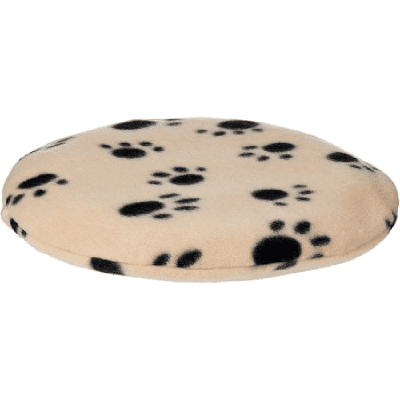
|
SnuggleSafe Microwave Wireless Heatpad with Fleece Cover |
|
CHECK PRICE | |

|
Me and My Pets Circular Woven Basket Bed |
|
CHECK PRICE |
The 8 Best Cat Beds In the UK
1. Petmate Self-Warming Cat Bed – Best Overall

| Bed type: | Round cat bed |
| Material: | Fabric |
The Petmate Self-Warming Cat Bed is our favourite cat bed available in the UK because it uses the same thermal technology that is used in space blankets to retain the body heat of your cat and provide a warm and snug environment in which to sleep. The self-warming pad is at the bottom of the bed and ensures that your cat is warm throughout the year without you having to use electricity or a microwave heat mat.
The cover can be spot-cleaned using a damp cloth, but it can also be removed and has successfully been placed in the washing machine in a low-temperature wash. Despite being an inexpensive cat bed, it is popular with cats and easy to clean.
However, it is small, and you may need the larger bed if you have a big cat that likes to spread out. Also, the soft sides do not offer support so you will need something more stable for cats that like to rest their limbs on something stable. Although it’s a relatively simple design, it is inexpensive and comfortable, while also offering warmth naturally, making it the best cat bed in the UK for the money.
- Self-warming bottom layer
- Cover can be machine-washed
- Cheap
- Smaller than expected
2. Petnap Standard Vinyl Electric Heat Mat – Best Value

| Bed type: | Heat mat |
| Material: | Fleece |
Some cats feel the cold more than others. In particular, those cats with joint pains and conditions like arthritis or joint dysplasia, are prone to pain and inflammation during cold weather. Cats with very short hair or no hair can also suffer from the cold. Some beds do a good job of providing natural insulation, but if your feline friend is especially prone to the chilly weather, you can buy a powered heat mat like the Petnap Standard Vinyl Electric Heat Mat.
It has a red zip fleece cover that can be removed for washing, but while the cable is armoured, this is not to protect against chewing or scratching. If your cat is likely to chew through the wire or scratch it until it frays, you should look for a different heated bed solution. When buying a heat mat in the UK, do ensure that it is suitable for our 230V mains, which this one is, otherwise it will be unusable.
The heat mat is effective, energy efficient, and at a very reasonable price, but it doesn’t suit cats that chew, some potential buyers will be put off by the bright red cover.
- Provides warmth whatever the weather
- Includes a removable and washable vinyl cover
- Decent price
- Not safe for cats that chew or scratch
- Bright red cover is not to everybody’s taste
3. Rosewood Thermo-Kitty Bed – Premium Choice

| Bed type: | Round bed |
| Material: | Foam |
The Rosewood Thermo-Kitty Bed is a heated round foam bed with a detachable machine washable cover. It has an orthopaedic base that provides support for cats’ limbs and ensures that they are comfortable, no matter their chosen position and even if they have joint complaints or other conditions that cause joint pain.
The Thermo-Kitty Bed also has a heating unit that is buried under the bottom layer. The bed detects when your cat or cats are laying on the bed and then warms the base. It doesn’t get too hot, and the heating layer can be removed during the hot weather so that your cat can still enjoy sleeping in its favourite bed in the summer. It is UK mains compatible, with a three-pin plug.
This is a reasonably priced bed, and it does a good job of warming your cat during the winter months, but the foam is easily misshapen if you’re not careful and there is no way to control the heat, which means the only method of heat control is to remove or add the heat mat ring back in.
- Provides warmth for cold cats
- Cushion and cover can be machine-washed
- Reasonably priced
- No control for heat or temperature
- Foam can become misshapen
4. SnuggleSafe Microwave Wireless Heatpad with Fleece Cover
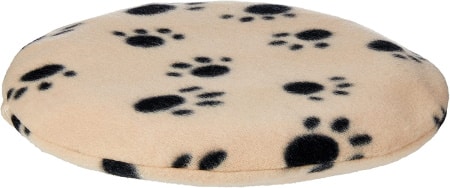
| Bed type: | Covered heat pad |
| Material: | Fleece |
The SnuggeSafe Microwave Wireless Heatpad is a microwavable pad that can be warmed in the microwave and that retains warmth for up to ten hours. Once it cools to room temperature, simply put it back in the microwave to make it warm again.
The pad also includes its own fleece liner, which can be removed and put in the washing machine to keep it clean and ensure it looks great and lasts longer. Because the heat pad is not powered and doesn’t plug in, it can be used both indoors and outdoors.
Do make sure you follow the heating instructions on the disc to avoid any injuries or problems. Also, the disc itself is hard and the fleece lining does nothing to make it more comfortable, so it will likely need covering with a softer bed, therefore preventing a lot of the heat from getting through. While SnuggleSafe says that it retains heat for up to 10 hours, it is likely that your heat pad will be cool after around 5 or 6 hours, but it is cheap, and it does serve a beneficial purpose for some cats.
- Cheap
- Fleece liner is machine washable
- Hard disc is uncomfortable
- Can be dangerous if you don’t follow microwave instructions properly
5. Me and My Pets Circular Woven Basket Bed

| Bed type: | Woven basket |
| Material: | Wicker |
The Me And My Pets Circular Woven Basket Bed is a simple wicker basket that includes a washable cushion for comfort. The basket is shaped so that it has a tall back for leaning against, and a short front to make access easy even for those cats with mobility problems or that cannot climb up. The cushion is fully washable, which means that the cover and the cushion itself go in the washing machine for easy maintenance.
The basket is reasonably priced, and its shape means that it is suitable for cats of all ages and most sizes.
The wicker does tend to slide and wobble on a hard floor, and some cats will scratch and even try chewing the handmade wicker, which can leave sharp sections protruding from the bed, while the cushion is thin so you will likely want to replace this with your cat’s preferred cushion to offer total comfort.
- Decent price
- Cushion and cover are machine washable
- Lowered front for easy access
- Cushion is thin and uncomfortable
- Wicker can wobble and ride around hard floors
6. Ossian Deluxe Cat Radiator Bed
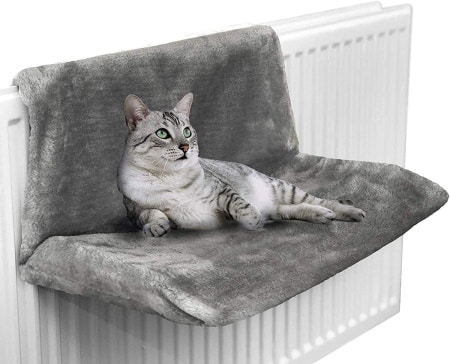
| Bed type: | Radiator hammock |
| Material: | Faux fur, alloy steel |
The Ossian Deluxe Cat Radiator Bed is made from an alloy steel frame that hangs over and uses the radiator as support, covered with a faux fur fabric that is comfortable and retains warmth for your cat.
It’s designed to keep your cat warm in winter, although it also provides a convenient perch and somewhere to sleep during the summer. The faux fur sleeve can be removed and machine-washed so that you can keep it looking clean and tidy. It is inexpensively priced, easy to assemble, and the steel frame is sturdy enough that it won’t bend or break even with regular use.
However, there is no way to zip or fix the sleeve on, so it does have a tendency to slip off, especially if your cat rolls and thrashes around while asleep. Also, the hooks seem to be designed to fit over a single radiator that has a grill cover on top and won’t work on double radiators or those without the cover.
- Steel frame is sturdy
- Faux fur cover is machine washable
- Cheap price
- Only fits certain radiator styles
- Cover doesn’t fix to the frame
7. Vertast Cat Cosy Igloo Bed
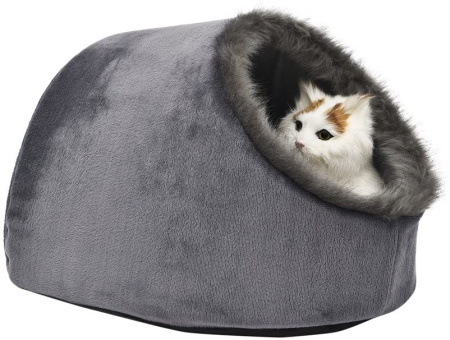
| Bed type: | Cat igloo |
| Material: | Fabric |
The Vertast Cat Igloo Bed is an igloo-shaped, faux fur bed. It is described as durable and cosy and it has a removable cushion that can be put in the washing machine to clean, although the rest of the bed must be spot cleaned using a sponge or some other cleaning method.
The bed arrives vacuum-packed, and it will require a day or so to spring back to its intended shape, but it is quite a flimsy cave and tends to fall in on itself and will certainly not withstand being stood on or scratched by your cat.
If you have a gentle cat that enjoys privacy and a little added warmth when sleeping, it is reasonably priced, and the igloo shape does provide a convenient cave in which your cat can enjoy restful slumber.
- Reasonable price
- Machine washable cushion
- Flimsy material doesn’t retain shape
- Bed can’t be machine-washed
8. Petkit Smart Cozy Pet House
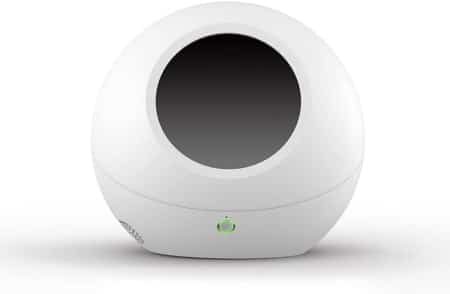
| Bed type: | Pod |
| Material: |
The Petkit Smart Cozy Pet House is an expensive pod-style house that has air conditioning and warming, as well as sensors and a thermostat that automatically detects the temperature and increases or decreases it to the desired level. Above the heater is a textured fabric that is designed to offer a comfortable perch on which your cat can lay and sleep, the smart bed offers app control via your mobile phone, and it even uses infrared sensors and provides a report on how often your cat uses the bed, and for how long.
As well as being expensive, this cat bed has a lot of controls, sensors, and other elements that can go wrong. The textured pad is not the most comfortable, and you will have to buy a plug adapter for use in the UK.
- Pod offers privacy
- Air-conditioned and heated
- Controlled via mobile phone app
- Very expensive
- Cushion is an uncomfortable pad
- Lots of parts to go wrong
Buyer’s Guide: Choosing the Best Cat Beds in the UK
Cats typically spend more than 15 hours a day asleep, and while some will happily sprawl on the floor and love sleeping in that position, others prefer the comfort of a soft surface and even the enclosed privacy and protection offered by clothes in drawers and other contained areas. Whatever your cat prefers, there is a style of bed out there to suit, and here you will find a guide to help you find the ideal bed for your sleepy, feline friend.
Bed Types
There are many types of cat beds on the market, including some that defy definition. The primary types, though, are:
- Standard Beds – The standard bed may be round or rectangular, has a cushioned base, and may or may not have walls around the bed. It is a simple design, is usually the cheapest option, and is suitable for a lot of cats. Some cats, however, will ignore the basic bed and still choose to sleep on furniture and in other spots around the house.
- Cat Caves – Cat caves are cave-shaped, made from a stiff fabric, and they almost envelop your cat. These are ideal if your cat likes to snuggle away in the airing cupboard or hide in amongst a pile of clothes because they provide the same feelings of safety and privacy that they would normally enjoy in these spots. Cats that do not like being covered may not like cat caves, which are also known as cat igloos.
- Pods – Cat pods are a little different. They are made from a firmer material and are akin to a small cabin or camping pod. They usually have a cushion or a cushioned blanket inside. They retain heat well, because the cat’s own body heat bounces off the pod walls and back at the sleeping cat. Some pods have a removable roof so that your cat can use it like a cat bowl bed. Many have legs to lift the bed off the floor, further improving the heat and offering some protection.
- Heated Beds – If you live in a very cold environment, or you have a hairless or short-haired cat, you may need to go the extra mile to provide a reasonable level of heating for your sleeping cat. Heated beds are usually electric and have a heating mat that is placed under the cushion of the bed. They may have heating controls so you can raise or lower the temperature, but others have a single setting that warms your cat rather than heats. You can also get heat mats to place under an existing bed, or microwave pads that are heated in the microwave and then placed under the cushion.
- Radiator Beds – Another way to provide heat to your cat is to use the heat from your home’s central heating. A radiator bed consists of a metal frame that hooks over the radiator and a hammock-style fabric cover on which the cat sleeps. The design is simple, but you do need to ensure that the metal frame is strong and sturdy enough that it won’t break or snap.
- Smart Bed – Smart beds are quite rare. They use thermostats and temperature sensors to determine the temperature in a pod-style bed. They allow total control over the ambient temperature, and some even include air conditioning to cool the bed down during the summer, as well as heaters to warm it up. These are expensive and are more than most cats or their owners usually need.
Features
There are dozens of cat beds on the market, and in many different styles, but whether you opt for a pod, radiator hammock, or a wicker basket, there are certain factors to consider that will determine the effectiveness and popularity of the bed.
Material
When it comes to the material of the bed itself, rather than the frame or legs, you will find that most beds are made from fleece or synthetic alternatives. Ensure that the material is not looped or your cat will get its claws stuck. If a cat bed does have a frame, it should be sturdy enough that it won’t be easily damaged and won’t break during use. Baskets and other sections should be similarly strong while providing the support that’s required.
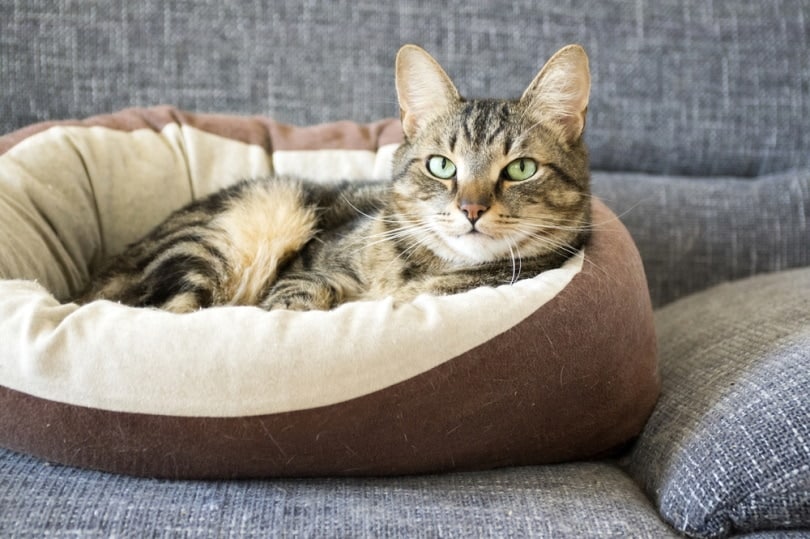
Size
Some cats like to sprawl out when sleeping while others prefer to curl up in a ball. Consider the actual size of your car as well as their preferred sleeping position and ensure that the bed you choose is large enough to comfortably contain your cat. Also look at the height of the front of the bed, especially if you have an arthritic cat or one that struggles to climb up and over high walls. High walls can prevent your cat from being able to rest its legs or chin, which some of our feline friends love to do.
Washable Cushions and Covers
Cat beds get hairy quickly, no matter the material of their construction. Ideally, the cover and potentially the cushion itself should be machine washable, making it easier to maintain and keep the bed clean. If a bed doesn’t say it’s machine washable, it may need hand washing or could only be suitable for spot cleaning with a sponge.
Conclusion
Cats love to sleep and can spend as many as 16 hours a day asleep. It is important to their continued good health and their development, as well as their emotional well-being and mood. As such, you need to find a comfortable bed that keeps them warm or cool and that they will enjoy sleeping in. We hope the reviews and guide above have helped you identify the best cat bed for your feline best friend.
We believe that the PetMate Self Warming Bed is simple, affordable, and uses your cat’s own body temperature to keep it warm during cold winter nights making it our easy top choice.
- See Also: Best Cat Food in the UK
Featured Photo Credit: Africa Studio, Shutterstock
Contents
- A Quick Comparison of Our Favourites in 2024
- The 8 Best Cat Beds In the UK
- 1. Petmate Self-Warming Cat Bed – Best Overall
- 2. Petnap Standard Vinyl Electric Heat Mat – Best Value
- 3. Rosewood Thermo-Kitty Bed – Premium Choice
- 4. SnuggleSafe Microwave Wireless Heatpad with Fleece Cover
- 5. Me and My Pets Circular Woven Basket Bed
- 6. Ossian Deluxe Cat Radiator Bed
- 7. Vertast Cat Cosy Igloo Bed
- 8. Petkit Smart Cozy Pet House
- Buyer’s Guide: Choosing the Best Cat Beds in the UK















